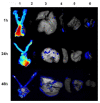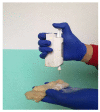Electrospun Nanofibers Revisited: An Update on the Emerging Applications in Nanomedicine
- PMID: 35269165
- PMCID: PMC8911671
- DOI: 10.3390/ma15051934
Electrospun Nanofibers Revisited: An Update on the Emerging Applications in Nanomedicine
Abstract
Electrospinning (ES) has become a straightforward and customizable drug delivery technique for fabricating drug-loaded nanofibers (NFs) using various biodegradable and non-biodegradable polymers. One of NF's pros is to provide a controlled drug release through managing the NF structure by changing the spinneret type and nature of the used polymer. Electrospun NFs are employed as implants in several applications including, cancer therapy, microbial infections, and regenerative medicine. These implants facilitate a unique local delivery of chemotherapy because of their high loading capability, wide surface area, and cost-effectiveness. Multi-drug combination, magnetic, thermal, and gene therapies are promising strategies for improving chemotherapeutic efficiency. In addition, implants are recognized as an effective antimicrobial drug delivery system overriding drawbacks of traditional antibiotic administration routes such as their bioavailability and dosage levels. Recently, a sophisticated strategy has emerged for wound healing by producing biomimetic nanofibrous materials with clinically relevant properties and desirable loading capability with regenerative agents. Electrospun NFs have proposed unique solutions, including pelvic organ prolapse treatment, viable alternatives to surgical operations, and dental tissue regeneration. Conventional ES setups include difficult-assembled mega-sized equipment producing bulky matrices with inadequate stability and storage. Lately, there has become an increasing need for portable ES devices using completely available off-shelf materials to yield highly-efficient NFs for dressing wounds and rapid hemostasis. This review covers recent updates on electrospun NFs in nanomedicine applications. ES of biopolymers and drugs is discussed regarding their current scope and future outlook.
Keywords: biopolymers; electrospinning; implants; nanofibers; nanomedicine; targeted delivery; wound healing.
Conflict of interest statement
The authors declare no conflict of interest.
Figures












References
-
- Taylor G.I. Disintegration of Water Drops in an Electric Field. Proc. R. Soc. Lond. Ser. A. Math. Phys. Sci. 1964;280:383–397. doi: 10.1098/rspa.1964.0151. - DOI
-
- Islam M.S., Ang B.C., Andriyana A., Afifi A.M. A Review on Fabrication of Nanofibers via Electrospinning and Their Applications. SN Appl. Sci. 2019;1:1248. doi: 10.1007/s42452-019-1288-4. - DOI
-
- Miletić A., Pavlić B., Ristić I., Zeković Z., Pilić B. Encapsulation of Fatty Oils into Electrospun Nanofibers for Cosmetic Products with Antioxidant Activity. Appl. Sci. 2019;9:2955. doi: 10.3390/app9152955. - DOI
Publication types
LinkOut - more resources
Full Text Sources
Miscellaneous

